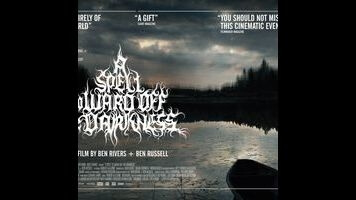One of the main misconceptions about heavy metal, often floated by the kind of people who wouldn’t be caught dead actually listening to the stuff, is that it’s all about hate and rage—the impotent tantrums thrown by angry little boys trapped in the black-clad bodies of burly men. But some of the best extreme music being made today runs a much wider spectrum of emotions, ranging from grief and loneliness to wonder and awe to near-religious euphoria. (Satan no longer has a monopoly on the genre, if he ever really did.) It’s the cathartic, even meditative qualities of metal that are explored in A Spell To Ward Off The Darkness, a new documentary whatsit that frequently resembles nothing so much as an adaptation of some imaginary black-metal record. The atmosphere is mythic and pervasive. The imagery, of night and nature and dancing flames, seems ripped from liner notes. Even the title sounds like something you might see scrawled across a record sleeve in Gothic typeface.
Proving that sometimes two (metal) heads are better than one, the film is also a portrait of an outsider artist from a pair of outsider artists: experimental documentarians Ben Rivers, from the U.K., and Ben Russell, from the U.S. They share not just a first name and last initial, but also an ethnographic interest, and an apparent willingness to blur the line between fiction and non-fiction. Their subject is Robert Aiki Aubrey Lowe, a Brooklyn-based musician who makes experimental vocal songs under the moniker Lichens and sometimes plays with drone metal giants Om. Spell unfolds across three distinct sections, with the nearly silent Lowe as the human through-line—the elusive star of this snail-paced triptych.
The first chapter observes an Estonian commune, eavesdropping on conversations about the metaphysical value of drone music and about a hot-tub party that ends with some collective butt play. (It’s the most talkative and, by extension, least interesting portion of the movie.) Russell and Rivers then shift to footage of Lowe wandering alone through the wilderness, pausing to fish on a serene lake and to stare into a bonfire; this wordless, beautifully filmed passage closely resembles Rivers’ first feature, Two Years At Sea, though the sense of isolation isn’t as carefully cultivated. Finally, Lowe smears on some corpse paint and joins a who’s who of Brooklyn metal musicians—including members of Liturgy, Krallice, and Behold… The Arctopus—for a half-hour set, captured by the filmmakers through a couple of gliding long takes. It’s hypnotic, like a seance set to power chords.
Those looking to learn something about Lowe—about his life, his music, his creative process—should fire up a search engine instead. Spell is more interested in the melancholy aura the musician gives off, in his usefulness as an existential cipher, and as such it fails to communicate much about the man beyond a vague sense of his talent. What’s clearer, in this Rorschach test of a mood piece, is the effort the Bens make to capture the misunderstood spirit of a musical genre. Their film is structured like a great black-metal anthem: building slowly from the eerie quiet of its early scenes, ballooning with mood as it expands outward, and then finally exploding in cathartic release. There’s a kinship between music this superficially “abrasive” and the kind of fringe filmmaking Rivers and Russell practice. Both mediums are challenging but rewarding, speaking to a niche audience willing to parse rough edges for meaning. A Spell To Ward Off The Darkness goes looking for transcendence in the mosh pit; it may be the most metal film of the year, at least for those who understand the full meaning of that compliment.

